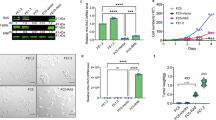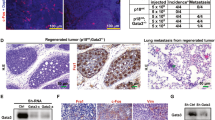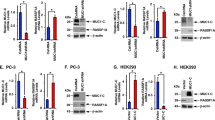Abstract
We have previously shown that Singleminded-2s (SIM2s), a member of the basic helix-loop-helix Per-Arnt-Sim (bHLH/PAS) family of transcription factors, is downregulated in breast cancer samples and has tumor suppressor activity. However, the mechanism by which SIM2s is repressed in breast cancer cells has not been determined. In this study, we show that transformation of MCF10A cells by Harvey-Ras (Ha-Ras) induces CCAAT/enhance binding protein β (C/EBPβ) and activates the NOTCH signaling pathway to block SIM2s gene expression. NOTCH-mediated repression acts through a C-repeat binding factor 1 (CBF1)-independent mechanism, as introduction of CBF1 had no effect on SIM2s expression. Consistent with C/ebpβ-dependent inhibition of SIM2s, C/ebpβ−/− mouse mammary glands express high levels of SIM2s and reestablishment of C/ebpβ isoforms decreased SIM2s mRNA levels in C/ebpβ immortalized mammary epithelial cell lines. These studies illustrate a novel pathway of tumor suppressor gene silencing in Ha-Ras-transformed breast epithelial cells and identify SIM2s as a target of C/EBPβ and NOTCH signaling.
This is a preview of subscription content, access via your institution
Access options
Subscribe to this journal
Receive 50 print issues and online access
$259.00 per year
only $5.18 per issue
Buy this article
- Purchase on Springer Link
- Instant access to full article PDF
Prices may be subject to local taxes which are calculated during checkout




Similar content being viewed by others
References
Aleman MJ, DeYoung MP, Tress M, Keating P, Perry GW, Narayanan R . (2005). Inhibition of Single Minded 2 gene expression mediates tumor-selective apoptosis and differentiation in human colon cancer cells. Proc Natl Acad Sci USA 102: 12765–12770.
Baldwin BR, Timchenko NA, Zahnow CA . (2004). Epidermal growth factor receptor stimulation activates the RNA binding protein CUG-BP1 and increases expression of C/EBPbeta-LIP in mammary epithelial cells. Mol Cell Biol 24: 3682–3691.
Bray SJ . (2006). Notch signalling: a simple pathway becomes complex. Nat Rev Mol Cell Biol 7: 678–689.
Crews S, Franks R, Hu S, Matthews B, Nambu J . (1992). Drosophila single-minded gene and the molecular genetics of CNS midline development. J Exp Zool 261: 234–244.
Descombes P, Schibler U . (1991). A liver enriched transcriptional activator protein, LAP, and a transcriptional inhibitors protein, LIP, are transcribed from the same mRNA. Cell 3: 569–579.
Deyoung MP, Scheurle D, Damania H, Zylberberg C, Narayanan R . (2002). Down's syndrome-associated single minded gene as a novel tumor marker. Anticancer Res 22: 3149–3157.
Dunn KL, Espino PS, Drobic B, He S, Davie JR . (2005). The Ras-MAPK signal transduction pathway, cancer and chromatin remodeling. Biochem Cell Biol 83: 1–14.
Gomis RR, Alarcon C, Nadal C, Van Poznak C, Massague J . (2006). C/EBPbeta at the core of the TGFbeta cytostatic response and its evasion in metastatic breast cancer cells. Cancer Cell 10: 203–214.
Grimm SL, Rosen JM . (2003). The role of C/EBPbeta in mammary gland development and breast cancer. J Mammary Gland Biol Neoplasia 8: 191–204.
Halvorsen OJ, Rostad K, Oyan AM, Puntervoll H, Bo TH, Stordrange L et al. (2007). Increased expression of SIM2-s protein is a novel marker of aggressive prostate cancer. Clin Cancer Res 13: 892–897.
Jarriault S, Brou C, Logeat F, Schroeter EH, Kopan R, Israel A . (1995). Signalling downstream of activated mammalian Notch. Nature 377: 355–358.
Kewley RJ, Whitelaw ML, Chapman-Smith A . (2004). The mammalian basic helix-loop-helix/PAS family of transcriptional regulators. Int J Biochem Cell Biol 36: 189–204.
Khleif SN, Abrams SI, Hamilton JM, Bergmann-Leitner E, Chen A, Bastian A et al. (1999). A phase I vaccine trial with peptides reflecting ras oncogene mutations of solid tumors. J Immunother 22: 155–165.
Kiaris H, Politi K, Grimm LM, Szabolcs M, Fisher P, Efstratiadis A et al. (2004). Modulation of Notch signaling elicits signature tumors and inhibits hras1-induced oncogenesis in the mouse mammary epithelium. Am J Pathol 165: 695–705.
Kwak HI, Gustafson T, Metz RP, Laffin B, Schedin P, Porter WW . (2007). Inhibition of breast cancer growth and invasion by single-minded 2s. Carcinogenesis 2: 259–266.
Laffin B, Wellberg E, Kwak HI, Burghardt RC, Metz RP, Gustafson T et al. (2008). Loss of Singleminded-2s in the mouse mammary gland induces an epithelial mesenchymal transition associated with up-regulation of Slug and MMP2. Mol Cell Biol 28: 1936–1946.
Lamb J, Ramaswamy S, Ford HL, Contreras B, Martinez RV, Kittrell FS et al. (2003). A mechanism of cyclin D1 action encoded in the patterns of gene expression in human cancer. Cell 114: 323–334.
Liu S, Dontu G, Wicha MS . (2005). Mammary stem cells, self-renewal pathways, and carcinogenesis. Breast Cancer Res 7: 86–95.
Martinez Arias A, Zecchini V, Brennan K . (2002). CSL-independent Notch signalling: a checkpoint in cell fate decisions during development? Curr Opin Genet Dev 12: 524–533.
Martinez-Lacaci I, Kannan S, De Santis M, Bianco C, Kim N, Wallace-Jones B et al. (2000). RAS transformation causes sustained activation of epidermal growth factor receptor and elevation of mitogen-activated protein kinase in human mammary epithelial cells. Int J Cancer 88: 44–52.
Metz RP, Kwak HI, Gustafson T, Laffin B, Porter WW . (2006). Differential transcriptional regulation by mouse single-minded 2S. J Biol Chem 281: 10839–10848.
Milde-Langosch K, Loning T, Bamberger AM . (2003). Expression of the CCAAT/enhancer-binding proteins C/EBPalpha, C/EBPbeta and C/EBPdelta in breast cancer: correlations with clinicopathologic parameters and cell-cycle regulatory proteins. Breast Cancer Res Treat 79: 175–185.
Nakajima T, Kinoshita S, Sasagawa T, Sasaki K, Naruto M, Kishimoto T et al. (1993). Phosphorylation at threonine-235 by a ras-dependent mitogen-activated protein kinase cascade is essential for transcription factor NF-IL6. Proc Natl Acad Sci USA 90: 2207–2211.
Nielsen LL, Discafani CM, Gurnani M, Tyler RD . (1991). Histopathology of salivary and mammary gland tumors in transgenic mice expressing a human Ha-ras oncogene. Cancer Res 51: 3762–3767.
Sansone P, Storci G, Giovannini C, Pandolfi S, Pianetti S, Taffurelli M et al. (2007). p66Shc/Notch-3 interplay controls self-renewal and hypoxia survival in human stem/progenitor cells of the mammary gland expanded in vitro as mammospheres. Stem Cells 25: 807–815.
Seagroves TN, Krnacik S, Raught B, Gay J, Burgess-Beusse B, Darlington GJ et al. (1998). C/EBPbeta, but not C/EBPalpha, is essential for ductal morphogenesis, lobuloalveolar proliferation, and functional differentiation in the mouse mammary gland. Genes Dev 12: 1917–1928.
Shim M, Powers KL, Ewing SJ, Zhu S, Smart RC . (2005). Diminished expression of C/EBPalpha in skin carcinomas is linked to oncogenic Ras and reexpression of C/EBPalpha in carcinoma cells inhibits proliferation. Cancer Res 65: 861–867.
Shuman JD, Sebastian T, Kaldis P, Copeland TD, Zhu S, Smart RC et al. (2004). Cell cycle-dependent phosphorylation of C/EBPbeta mediates oncogenic cooperativity between C/EBPbeta and H-RasV12. Mol Cell Biol 24: 7380–7391.
Sinn E, Muller W, Pattengale P, Tepler I, Wallace R, Leder P . (1987). Coexpression of MMTV/v-Ha-ras and MMTV/c-myc genes in transgenic mice: synergistic action of oncogenes in vivo. Cell 49: 465–475.
Slamon DJ, Godolphin W, Jones LA, Holt JA, Wong SG, Keith DE et al. (1989). Studies of the HER-2/neu proto-oncogene in human breast and ovarian cancer. Science 244: 707–712.
Stylianou S, Clarke RB, Brennan K . (2006). Aberrant activation of Notch signaling in human breast cancer. Cancer Res 66: 1517–1525.
Sundaram MV . (2005). The love-hate relationship between Ras and Notch. Genes Dev 19: 1825–1839.
von Lintig FC, Dreilinger AD, Varki NM, Wallace AM, Casteel DE, Boss GR . (2000). Ras activation in human breast cancer. Breast Cancer Res Treat 62: 51–62.
Weijzen S, Rizzo P, Braid M, Vaishnav R, Jonkheer SM, Zlobin A et al. (2002). Activation of Notch-1 signaling maintains the neoplastic phenotype in human Ras-transformed cells. Nat Med 8: 979–986.
Yu Q, Geng Y, Sicinski P . (2001). Specific protection against breast cancers by cyclin D1 ablation. Nature 411: 1017–1021.
Zahnow CA . (2002). CCAAT/enhancer binding proteins in normal mammary development and breast cancer. Breast Cancer Res 4: 113–121.
Zahnow CA, Cardiff RD, Laucirica R, Medina D, Rosen JM . (2001). A role for CCAAT/enhancer binding protein beta-liver-enriched inhibitory protein in mammary epithelial cell proliferation. Cancer Res 61: 261–269.
Zahnow CA, Younes P, Laucirica R, Rosen JM . (1997). Overexpression of C/EBPbeta-LIP, a naturally occurring, dominant-negative transcription factor, in human breast cancer. J Natl Cancer Inst 89: 1887–1891.
Zhu S, Yoon K, Sterneck E, Johnson PF, Smart RC . (2002). CCAAT/enhancer binding protein-beta is a mediator of keratinocyte survival and skin tumorigenesis involving oncogenic Ras signaling. Proc Natl Acad Sci USA 99: 207–212.
Acknowledgements
We thank Bryan and Alana Welm (Huntsman Cancer Institute, Salt Lake City, UT, USA) for the Ha-Ras parent construct, Jeff Rosen (Baylor College of Medicine, Houston, TX, USA) for providing the C/ebpβ−/− mammary glands and Michael Lewis (Baylor College of Medicine, Houston, TX, USA) for critical reading of the paper. We also thank Keelan Anderson for technical assistance. This work was supported by awards from the National Cancer Institute RO1CA111551 (WWP), R01CA113795 (CAZ) and Howard Hughes Medical Institute Predoctoral Fellowship (TG).
Author information
Authors and Affiliations
Corresponding author
Additional information
Supplementary Information accompanies the paper on the Oncogene website (http://www.nature.com/onc)
Supplementary information
Rights and permissions
About this article
Cite this article
Gustafson, T., Wellberg, E., Laffin, B. et al. Ha-Ras transformation of MCF10A cells leads to repression of Singleminded-2s through NOTCH and C/EBPβ. Oncogene 28, 1561–1568 (2009). https://doi.org/10.1038/onc.2008.497
Received:
Revised:
Accepted:
Published:
Issue Date:
DOI: https://doi.org/10.1038/onc.2008.497
Keywords
This article is cited by
-
C/EBPß Isoform Specific Gene Regulation: It’s a Lot more Complicated than you Think!
Journal of Mammary Gland Biology and Neoplasia (2020)
-
Loss of SIM2s inhibits RAD51 binding and leads to unresolved replication stress
Breast Cancer Research (2019)
-
Cross-talk between SIM2s and NFκB regulates cyclooxygenase 2 expression in breast cancer
Breast Cancer Research (2019)
-
ATM-dependent activation of SIM2s regulates homologous recombination and epithelial–mesenchymal transition
Oncogene (2019)
-
Regulation of DCIS to invasive breast cancer progression by Singleminded-2s (SIM2s)
Oncogene (2013)



